Water Demand Scenarios for Electricity Generation at the Global and Regional Levels
Abstract
1. Introduction
2. Data and Methodology
2.1. Future Electricity Generation Pathways
2.2. Future Cooling Technology Scenarios
2.3. Estimated Water Use Intensity by Energy Source and Technology
2.4. Calculating Water Use for Future Global and Regional Electricity Generation
3. Results
3.1. Comparison of Transition Pathways for the Electricity Sector
3.2. Impact of Electricity Generation Pathways on Future Global Water Demand
3.3. Impacts of Electricity Demand on Global Water Demand
3.4. Impacts of Cooling and Electricity Generation Technologies on Global Water Consumption
3.5. Impact of Electricity Generation Pathways on the Future Regional Water Demand
4. Discussion
4.1. Seawater
4.2. Carbon Capture and Storage (CCS)
4.3. Efficiency Improvements
4.4. Indirect Water Demand for Power Generation
5. Conclusions
Author Contributions
Funding
Conflicts of Interest
Appendix A
| Energy Source | Power Plant Type | Cooling System | Cooling Water Requirement (m3/MWh) | |
|---|---|---|---|---|
| Withdrawal | Consumption | |||
| Coal | ST | 1T-BSW | 89.788 | 0.410 |
| 1T | 85.512 | 0.390 | ||
| CMB | 80.000 | 0.390 | ||
| CP | 56.955 | 0.159 | ||
| CT | 2.305 | 1.866 | ||
| DC | 0.132 | 0.132 | ||
| GT | 1T-BSW | 144.480 | 0.993 | |
| 1T | 137.600 | 0.946 | ||
| CT | 3.804 | 2.601 | ||
| CC | 1T-BSW | 3.994 | 2.731 | |
| 1T | 43.078 | 0.379 | ||
| CT | 0.958 | 0.750 | ||
| Dry | 0.008 | 0.008 | ||
| Natural gas | ST | 1T-BSW | 139.113 | 0.953 |
| 1T | 132.489 | 0.908 | ||
| CMB | 80.000 | 0.908 | ||
| CP | 1.703 | 1.476 | ||
| CT | 4.554 | 3.127 | ||
| Dry | 0.132 | 0.132 | ||
| GT | 1T-BSW | 139.113 | 0.953 | |
| 1T | 132.489 | 0.908 | ||
| CT | 4.554 | 3.127 | ||
| Dry | 0.132 | 0.132 | ||
| CC | 1T-BSW | 45.232 | 0.398 | |
| 1T | 43.078 | 0.379 | ||
| CP | 22.523 | 0.908 | ||
| CT | 0.958 | 0.750 | ||
| Dry | 0.008 | 0.008 | ||
| Oil | ST | 1T-BSW | 139.113 | 0.953 |
| 1T | 132.489 | 0.908 | ||
| CP | 26.687 | 2.309 | ||
| CT | 4.554 | 3.127 | ||
| Dry | 0.132 | 0.132 | ||
| GT | 1T-BSW | 139.113 | 0.953 | |
| 1T | 132.489 | 0.908 | ||
| CT | 4.554 | 3.127 | ||
| CP | 22.523 | 0.908 | ||
| DC | 0.132 | 0.132 | ||
| CC | 1T-BSW | 45.232 | 0.398 | |
| 1T | 43.078 | 0.379 | ||
| CT | 0.958 | 0.750 | ||
| DC | 0.008 | 0.008 | ||
| Nuclear | ST | 1T-BSW | 176.277 | 1.069 |
| 1T | 167.883 | 1.018 | ||
| CMB | 100.000 | 2.000 | ||
| CP | 26.687 | 2.309 | ||
| CT | 4.168 | 2.544 | ||
| Dry | 0.132 | 0.132 | ||
| CC | 1T-BSW | 105.766 | 0.641 | |
| 1T | 100.730 | 0.611 | ||
| CMB | 60.000 | 1.200 | ||
| CP | 16.012 | 1.385 | ||
| CT | 2.501 | 1.526 | ||
| DC | 0.079 | 0.079 | ||
| Biomass ** | ST | 1T-BSW | 139.113 | 1.193 |
| 1T | 132.489 | 1.136 | ||
| CMB | 80.000 | 1.136 | ||
| CT | 3.324 | 2.093 | ||
| Dry | 0.132 | 0.132 | ||
| GT | 1T-BSW | 139.113 | 1.193 | |
| 1T | 132.489 | 1.136 | ||
| CT | 3.324 | 0.890 | ||
| CC | 1T-BSW | 45.232 | 0.398 | |
| 1T | 43.078 | 0.379 | ||
| CT | 0.958 | 0.750 | ||
| Dry | 0.008 | 0.008 | ||
| Geothermal | ST/Others | 1T-BSW | 139.113 | 0.953 |
| 1T | 132.489 | 0.908 | ||
| CP | 6.820 | 1.480 | ||
| CT | 6.820 | 6.820 | ||
| DC | 0.670 | 0.670 | ||
| Solar | CSP | CT | 3.274 | 3.274 |
| Dry | 0.098 | 0.098 | ||
| PV * | none | 0.098 | 0.098 | |
| Wind | none | 0.000 | 0.000 | |
| Hydro ** | none | 0.000 | 17.000 | |
References
- Rodriguez, D.J.; Delgado, A.; DeLaquil, P.; Sohns, A. Thirsty Energy; Water Papers; World Bank: Washington, DC, USA, 2013. [Google Scholar]
- OECD/IEA. Water-Energy Nexus; World Energy Outlook 2016 Excerpt; International Energy Agency: Paris, France, 2016. [Google Scholar]
- IRENA. Renewable Energy in the Water, Energy and Food Nexus; International Renewable Energy Agency: Abu Dhabi, UAE, 2015. [Google Scholar]
- Roehrkasten, S.; Schaeuble, D.; Helgenberger, S. Secure and Sustainable Power Generation in a Water-Constrained World. In Proceedings of the South African International Renewable Energy Conference, Cape Town, South Africa, 4–7 October 2015. [Google Scholar]
- Förster, H.; Lilliestam, J. Modeling thermoelectric power generation in view of climate change. Reg. Environ. Chang. 2010, 10, 327–338. [Google Scholar] [CrossRef]
- Bauer, N.; Calvin, K.; Emmerling, J.; Fricko, O.; Fujimori, S.; Hilaire, J.; De Boer, H.S. Shared socio-economic pathways of the energy sector–quantifying the narratives. Glob. Environ. Chang. 2017, 42, 316–330. [Google Scholar] [CrossRef]
- Davies, E.G.; Kyle, P.; Edmonds, J.A. An integrated assessment of global and regional water demands for electricity generation to 2095. Adv. Water Resour. 2013, 52, 296–313. [Google Scholar] [CrossRef]
- Van Vuuren, D.P.; Nakicenovic, N.; Riahi, K.; Brew-Hammond, A.; Kammen, D.; Modi, V.; Smith, K.R. An energy vision: The transformation towards sustainability—Interconnected challenges and solutions. Curr. Opin. Environ. Sustain. 2012, 4, 18–34. [Google Scholar] [CrossRef]
- Kyle, P.; Davies, E.G.; Dooley, J.J.; Smith, S.J.; Clarke, L.E.; Edmonds, J.A.; Hejazi, M. Influence of climate change mitigation technology on global demands of water for electricity generation. Int. J. Greenh. Gas Control 2013, 13, 112–123. [Google Scholar] [CrossRef]
- Dooley, J.J.; Kyle, P.; Davies, E.G. Climate mitigation’s impact on global and regional electric power sector water use in the 21st Century. Energy Procedia 2013, 37, 2470–2478. [Google Scholar] [CrossRef]
- Jin, Y.; Behrens, P.; Tukker, A.; Scherer, L. Water use of electricity technologies: A global meta-analysis. Renew. Sustain. Energy Rev. 2019, 115, 109391. [Google Scholar] [CrossRef]
- Kummu, M.; Guillaume, J.H.A.; De Moel, H.; Eisner, S.; Flörke, M.; Porkka, M.; Ward, P.J. The world’s road to water scarcity: Shortage and stress in the 20th century and pathways towards sustainability. Sci. Rep. 2016, 6, 38495. [Google Scholar] [CrossRef]
- IEA. Making the Energy Sector More Resilient to Climate Change; OECD/IEA: Paris, France, 2015. [Google Scholar]
- Schaeffer, R.; Szklo, A.S.; De Lucena, A.F.P.; Borba, B.S.M.C.; Nogueira, L.P.P.; Fleming, F.P.; Boulahya, M.S. Energy sector vulnerability to climate change: A review. Energy 2012, 38, 1–12. [Google Scholar] [CrossRef]
- Chandel, M.K.; Pratson, L.F.; Jackson, R.B. The potential impacts of climate-change policy on freshwater use in thermoelectric power generation. Energy Policy 2011, 39, 6234–6242. [Google Scholar] [CrossRef]
- Strzepek, K.M.; Baker, J.; Farmer, W.; Schlosser, C.A. Modeling Water Withdrawal and Consumption for Electricity Generation in the United States; Joint Program Report Series Report 222; MIT Joint Program on the Science and Policy of Global Change: Cambridge, MA, USA, 2012. [Google Scholar]
- Baker, J.; Strzepek, K.; Farmer, W.; Schlosser, C.A. Quantifying the impact of renewable energy futures on cooling water use. JAWRA J. Am. Water Resour. Assoc. 2014, 50, 1289–1303. [Google Scholar] [CrossRef]
- Liu, L.; Hejazi, M.; Patel, P.; Kyle, P.; Davies, E.; Zhou, Y.; Clark, L.; Edmonds, J. Water demands for electricity generation in the US: Modeling different scenarios for the water-energy nexus. Technol. Forecast. Soc. Chang. 2015, 94, 318–334. [Google Scholar] [CrossRef]
- Talati, S.; Zhai, H.; Kyle, G.P.; Morgan, M.G.; Patel, P.; Liu, L. Consumptive water use from electricity generation in the southwest under alternative climate, technology, and policy futures. Environ. Sci. Technol. 2016, 50, 12095–12104. [Google Scholar] [CrossRef] [PubMed]
- Lin, L.; Chen, Y.D. Evaluation of Future Water Use for Electricity Generation under Different Energy Development Scenarios in China. Sustainability 2017, 10, 30. [Google Scholar] [CrossRef]
- Liao, X.; Hall, J.W.; Eyre, N. Water use in China’s thermoelectric power sector. Glob. Environ. Chang. 2016, 41, 142–152. [Google Scholar] [CrossRef]
- Zheng, X.; Wang, C.; Cai, W.; Kummu, M.; Varis, O. The vulnerability of thermoelectric power generation to water scarcity in China: Current status and future scenarios for power planning and climate change. Appl. Energy 2016, 171, 444–455. [Google Scholar] [CrossRef]
- Van Vliet, M.T.; Yearsley, J.R.; Ludwig, F.; Vögele, S.; Lettenmaier, D.P.; Kabat, P. Vulnerability of US and European electricity supply to climate change. Nat. Clim. Chang. 2012, 2, 676. [Google Scholar] [CrossRef]
- Byers, E.A.; Hall, J.W.; Amezaga, J.M. Electricity generation and cooling water use: UK pathways to 2050. Glob. Environ. Chang. 2014, 25, 16–30. [Google Scholar] [CrossRef]
- Murrant, D.; Quinn, A.; Chapman, L.; Heaton, C. Water use of the UK thermal electricity generation fleet by 2050: Part 1 identifying the problem. Energy Policy 2017, 108, 844–858. [Google Scholar] [CrossRef]
- Murrant, D.; Quinn, A.; Chapman, L.; Heaton, C. Water use of the UK thermal electricity generation fleet by 2050: Part 2 quantifying the problem. Energy Policy 2017, 108, 859–874. [Google Scholar] [CrossRef]
- Mitra, B.K.; Bhattacharya, A.; Zhou, X. A critical review of long term water energy nexus in India. In Proceedings of the Nexus 2014: Water, Food, Climate and Energy Conference, Chapel Hill, NC, USA, 3–7 March 2014. [Google Scholar]
- Flörke, M.; Bärlund, I.; Kynast, E. Will climate change affect the electricity production sector? A European study. J. Water Clim. Chang. 2012, 3, 44–54. [Google Scholar] [CrossRef]
- Srinivasan, S.; Kholod, N.; Chaturvedi, V.; Ghosh, P.P.; Mathur, R.; Clarke, L.; Liu, B. Water for electricity in India: A multi-model study of future challenges and linkages to climate change mitigation. Appl. Energy 2018, 210, 673–684. [Google Scholar] [CrossRef]
- Senger, M.; Spataru, C. Water-energy-land nexus-modelling long-term scenarios for Brazil. In Proceedings of the 2015 IEEE European Modelling Symposium (EMS), Madrid, Spain, 6–8 October 2015; pp. 266–271. [Google Scholar]
- Thopil, G.A.; Pouris, A. A 20 year forecast of water usage in electricity generation for South Africa amidst water scarce conditions. Renew. Sustain. Energy Rev. 2016, 62, 1106–1121. [Google Scholar] [CrossRef]
- Damerau, K.; Van Vliet, O.P.; Patt, A.G. Direct impacts of alternative energy scenarios on water demand in the Middle East and North Africa. Clim. Chang. 2015, 130, 171–183. [Google Scholar] [CrossRef]
- World Energy Council. Water for Energy; World Energy Council: London, UK, 2010. [Google Scholar]
- Fricko, O.; Parkinson, S.C.; Johnson, N.; Strubegger, M.; Van Vliet, M.T.; Riahi, K. Energy sector water use implications of a 2 C climate policy. Environ. Res. Lett. 2016, 11, 034011. [Google Scholar] [CrossRef]
- Ando, N.; Yoshikawa, S.; Fujimori, S.; Kanae, S. Long-term projections of global water use for electricity generation under the shared socioeconomic pathways and climate mitigation scenarios. Hydrol. Earth Syst. Sci. Discuss 2017, 2017, 1–25. [Google Scholar]
- Samadi, S.; Terrapon-Pfaff, J.; Lechtenböhmer, S.; Knoop, K. Long-term low greenhouse gas emission development strategies for achieving the 1.5 °C target—Insights from a comparison of German bottom-up energy scenarios. Carbon Manag. 2018, 9, 549–562. [Google Scholar] [CrossRef]
- Keles, D.; Möst, D.; Fichtner, W. The development of the German energy market until 2030—A critical survey of selected scenarios. Energy Policy 2011, 39, 812–825. [Google Scholar] [CrossRef]
- IEA/OECD. World Energy Outlook 2017; IEA/OECD: Paris, France, 2017. [Google Scholar]
- Teske, S.; Pregger, T.; Simon, S.; Naegler, T.; Crijns-Graus, W.H.; Lins, C. Energy [R]evolution 2010—A sustainable world energy outlook. Energy Effic. 2010, 4, 409–433. [Google Scholar] [CrossRef]
- Kitous, A.; Keramidas, K.; Vandyck, T.; Saveyn, B.; Van Dingenen, R.; Spadaro, J.; Holland, M. Global Energy and Climate Outlook 2017: How Climate Policies Improve Air Quality—Global Energy Trends and Ancillary Benefits of the Paris Agreement; EUR 28798 EN; Publications Office of the European Union: Luxembourg, 2017; ISBN 978-92-79-73864-7. [Google Scholar] [CrossRef]
- Flörke, M.; Kynast, E.; Bärlund, I.; Eisner, S.; Wimmer, F.; Alcamo, J. Domestic and industrial water uses of the past 60 years as a mirror of socio-economic development: A global simulation study. Glob. Environ. Chang. 2013, 23, 144–156. [Google Scholar] [CrossRef]
- Eisner, S. Comprehensive Evaluation of the WaterGAP3 Model Across Climatic, Physiographic, and Anthropogenic Gradients. Ph.D. Thesis, University of Kassel, Kassel, Germnay, 2016. [Google Scholar]
- Müller Schmied, H.; Eisner, S.; Franz, D.; Wattenbach, M.; Portmann, F.T.; Flörke, M.; Döll, P. Sensitivity of simulated global-scale freshwater fluxes and storages to input data, hydrological model structure, human water use and calibration. Hydrol. Earth Syst. Sci. Discuss. 2014, 11, 1583–1649. [Google Scholar] [CrossRef]
- Aus der Beek, T.; Flörke, M.; Lapola, D.M.; Schaldach, R. Modelling historical and current irrigation water demand on the continental scale: Europe. Adv. Geosci. 2010, 27, 79–85. [Google Scholar] [CrossRef]
- Bergesen, C. UDI World Electric Power Plants Data Base; Platts: Washington, DC, USA, 2010. [Google Scholar]
- Macknick, J.; Newmark, R.; Heath, G.; Hallett, K.C. Operational water consumption and withdrawal factors for electricity generating technologies: A review of existing literature. Environ. Res. Lett. 2012, 7, 045802. [Google Scholar] [CrossRef]
- Cooley, H.; Fulton, J.; Gleick, P.H.; Ross, N.; Luu, P. Water for Energy: Future Water Needs for Electricity in the Intermountain West; Pacific Institute: Oakland, CA, USA, 2011. [Google Scholar]
- Pan, S.Y.; Snyder, S.W.; Packman, A.I.; Lin, Y.J.; Chiang, P.C. Cooling water use in thermoelectric power generation and its associated challenges for addressing water-energy nexus. Water-Energy Nexus 2018, 1, 26–41. [Google Scholar] [CrossRef]
- Lin, L.; Chen, Y.D. Evaluation of Future Water Use for Electricity Generation under Different Energy Development Scenarios in China. Sustainability 2018, 10, 30. [Google Scholar] [CrossRef]
- Gleick, P.H. Water and energy. Annu. Rev. Energy Environ. 1994, 19, 267–299. [Google Scholar] [CrossRef]
- Qin, Y.; Mueller, N.D.; Siebert, S.; Jackson, R.B.; AghaKouchak, A.; Zimmerman, J.B.; Tong, D.; Hong, C.; Davis, S.J. Flexibility and intensity of global water use. Nat. Sustain. 2019, 2, 515–523. [Google Scholar] [CrossRef]
- Bakken, T.H.; Killingtveit, Å.; Alfredsen, K. The water footprint of hydropower production—State of the art and methodological Challenges. Glob. Chall. 2017, 1, 1600018. [Google Scholar] [CrossRef]
- Spang, E.S.; Moomaw, W.R.; Gallagher, K.S.; Kirshen, P.H.; Marks, D.H. The water consumption of energy production: An international comparison. Environ. Res. Lett. 2014, 9, 105002. [Google Scholar] [CrossRef]
- Mekonnen, M.M.; Gerbens-Leenes, P.W.; Hoekstra, A.Y. Future electricity: The challenge of reducing both carbon and water footprint. Sci. Total Environ. 2016, 569, 1282–1288. [Google Scholar] [CrossRef]
- Magneschi, G.; Zhang, T.; Munson, R. The impact of CO2 capture on water requirements of power plants. Energy Procedia 2017, 114, 6337–6347. [Google Scholar] [CrossRef]
- Meldrum, J.; Nettles-Anderson, S.; Heath, G.; Macknick, J. Life cycle water use for electricity generation: A review and harmonization of literature estimates. Environ. Res. Lett. 2013, 8, 015031. [Google Scholar] [CrossRef]
- Schomberg, A.; Flörke, M.; Campos, J.; Sebesvari, Z.; Terrapon-Pfaff, J.; Amroune, S.; Viebahn, P.; Benelcadi, H.; Jähnig, S.; Landwehr, T.; et al. Requirements for a Water Footprint Approach to Compare Different Energy Generation Systems. In Proceedings of the Mid-Term Conference–Frankfurt am Main, Frankfurt, Germany, 20–21 February 2019; p. 44. [Google Scholar]
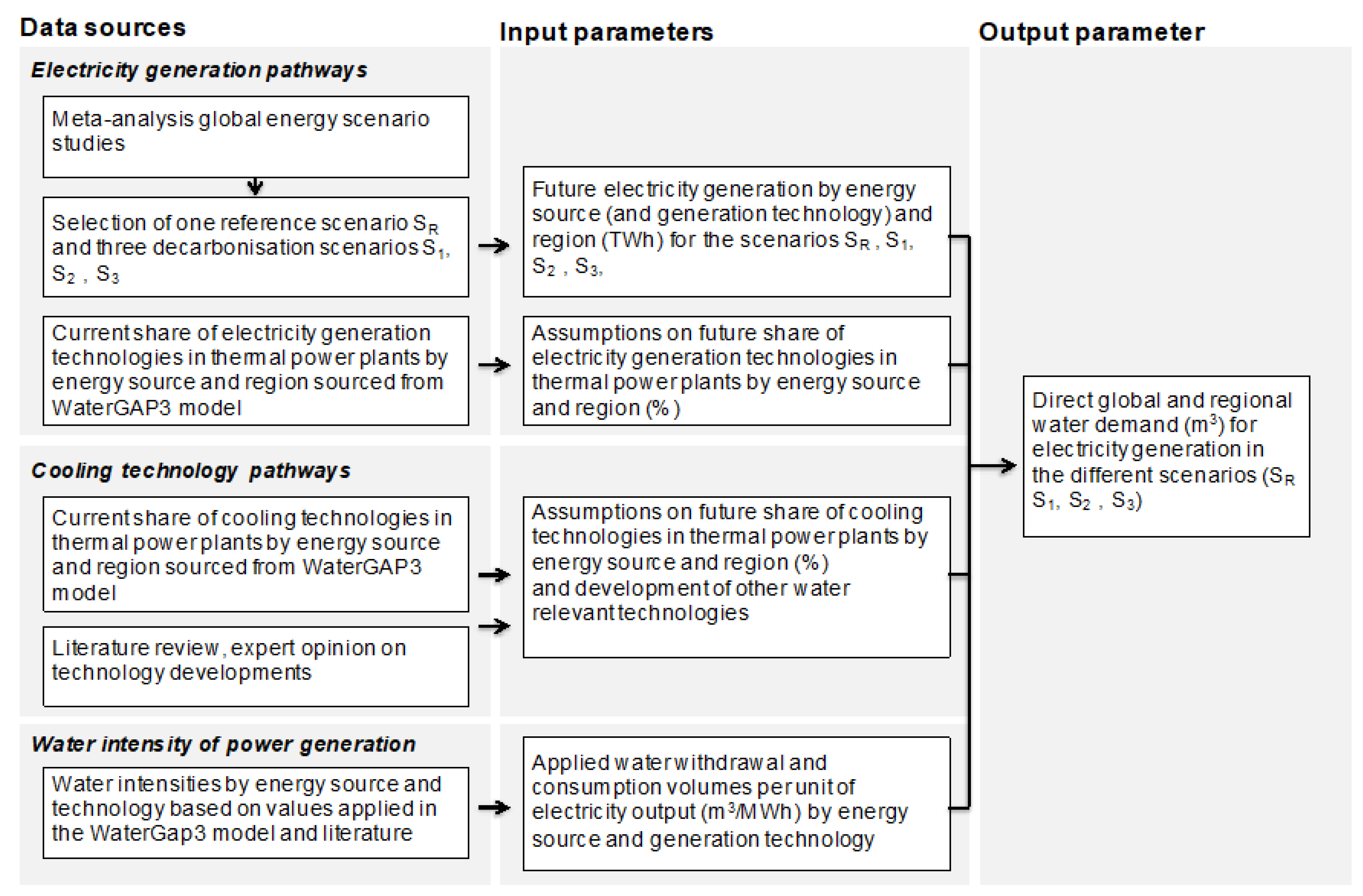
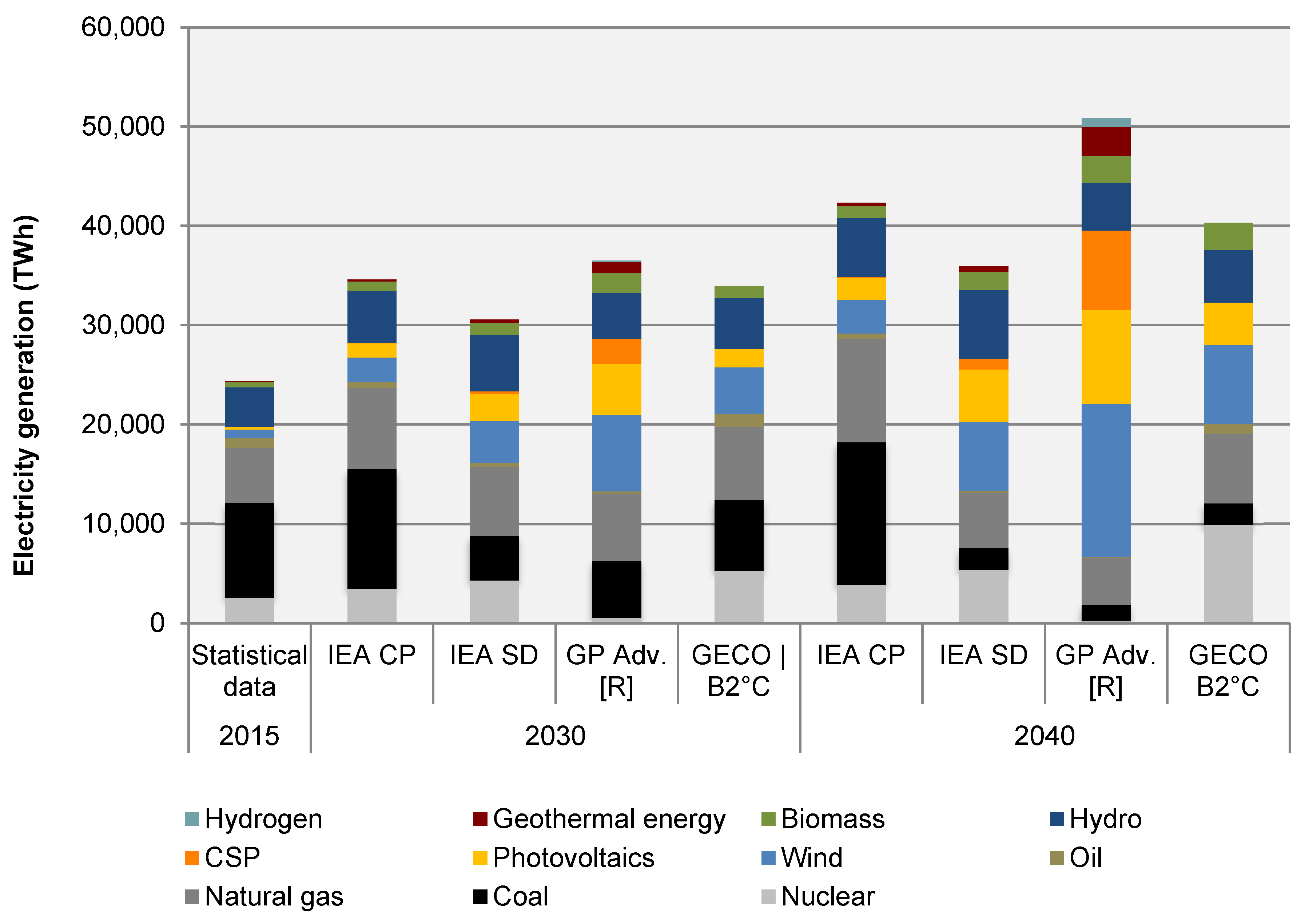
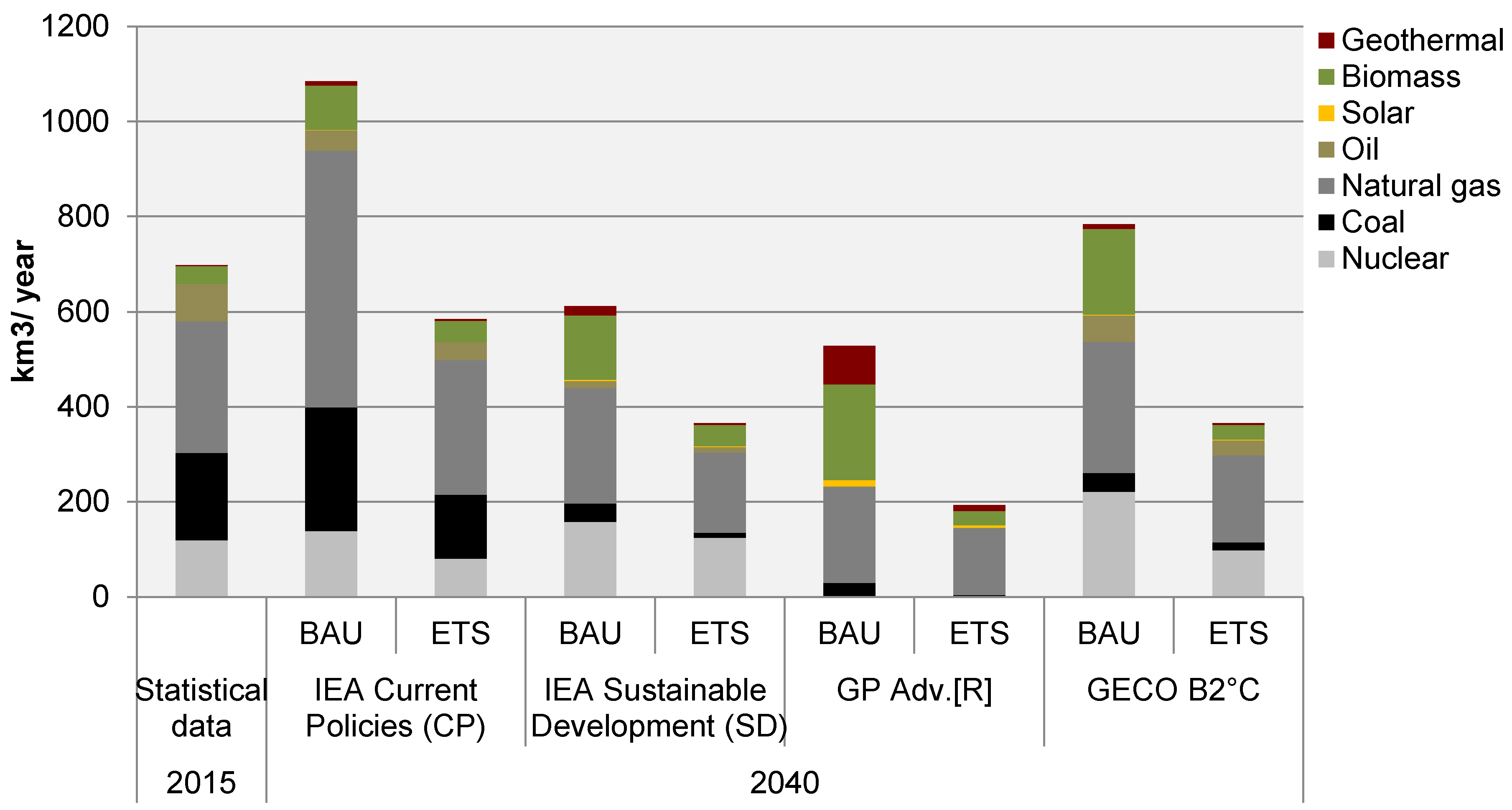
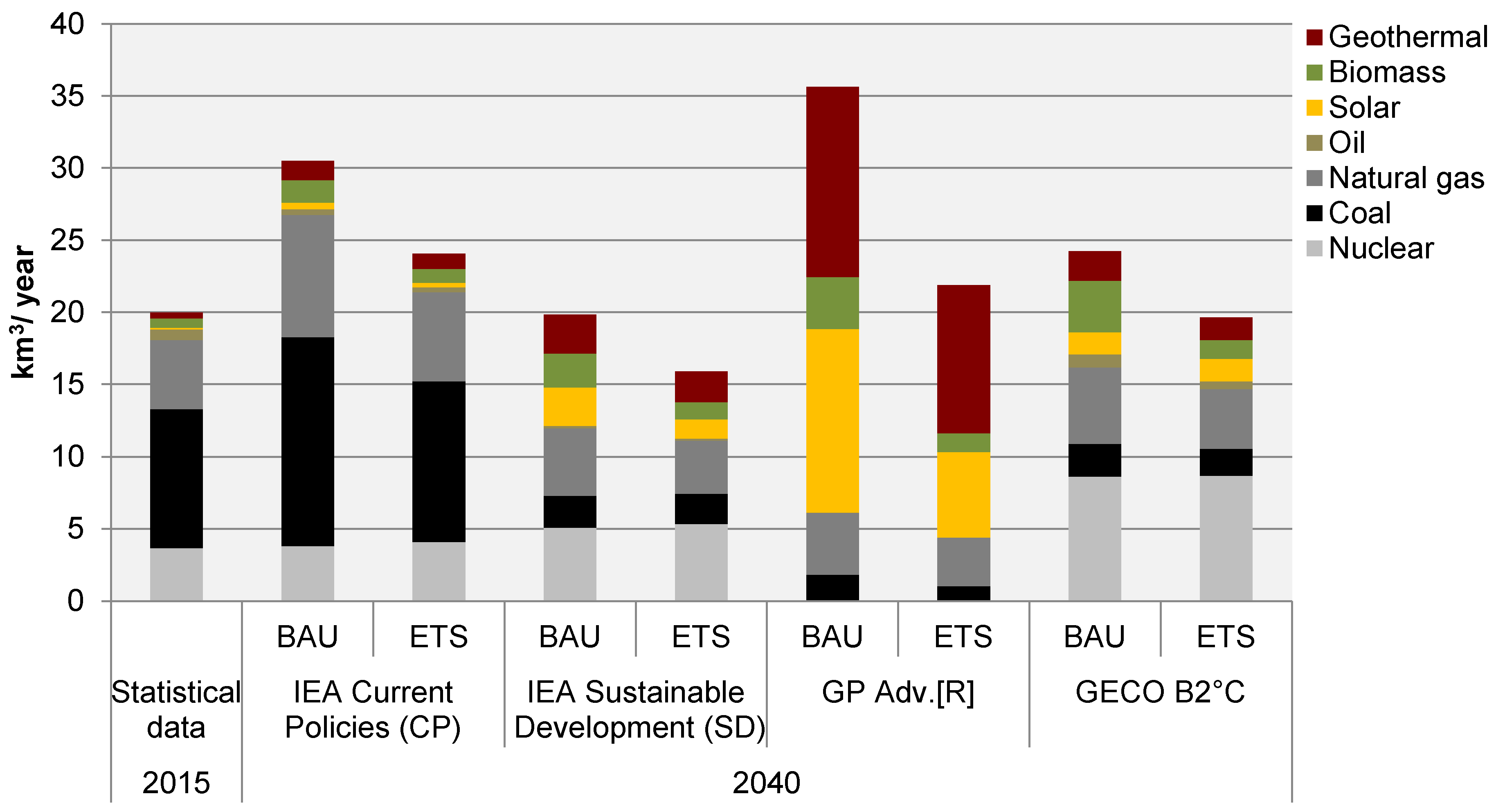
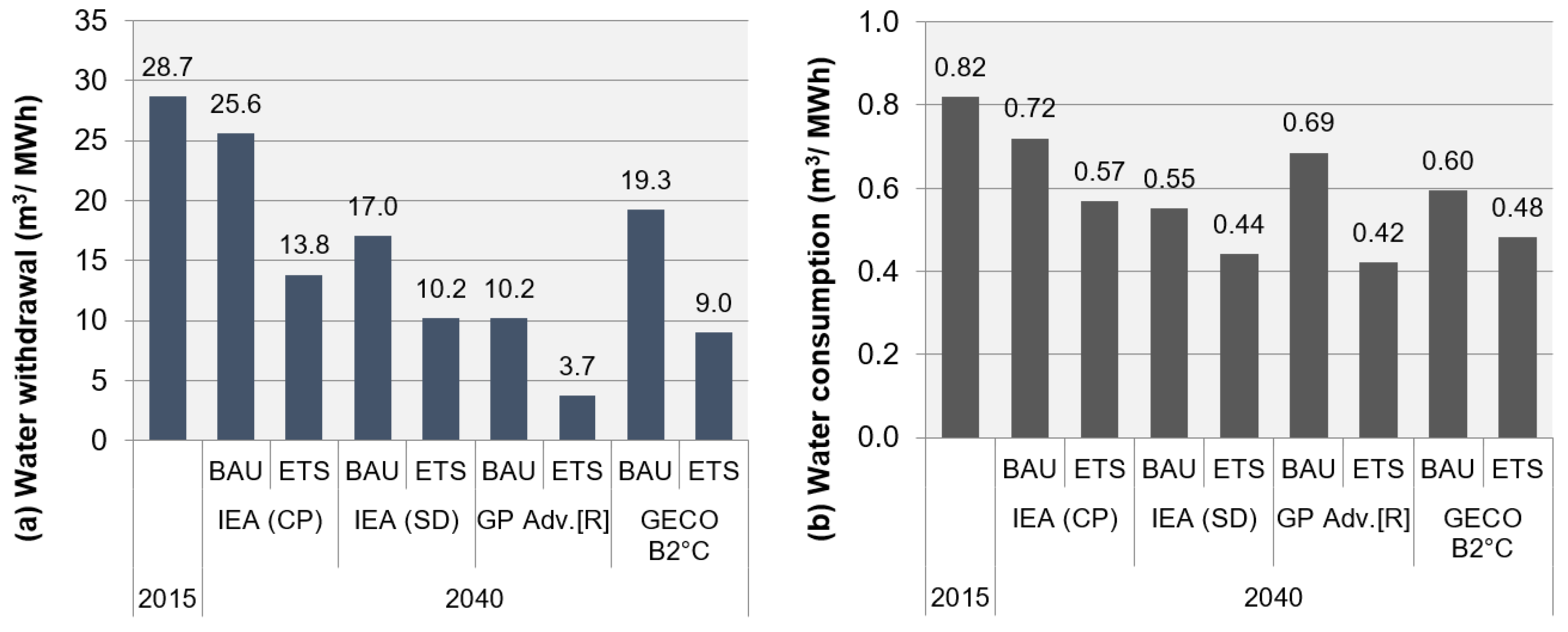

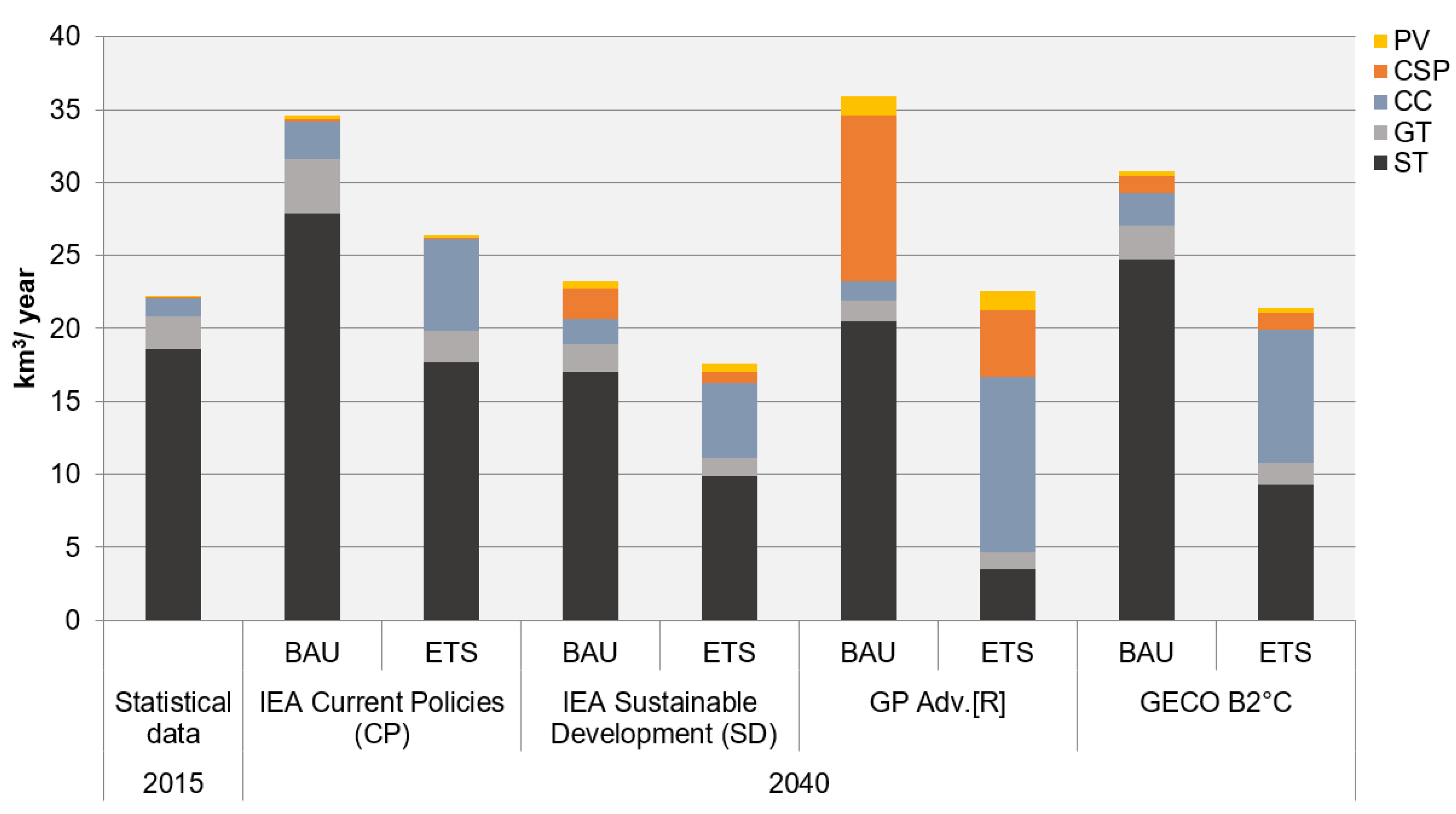

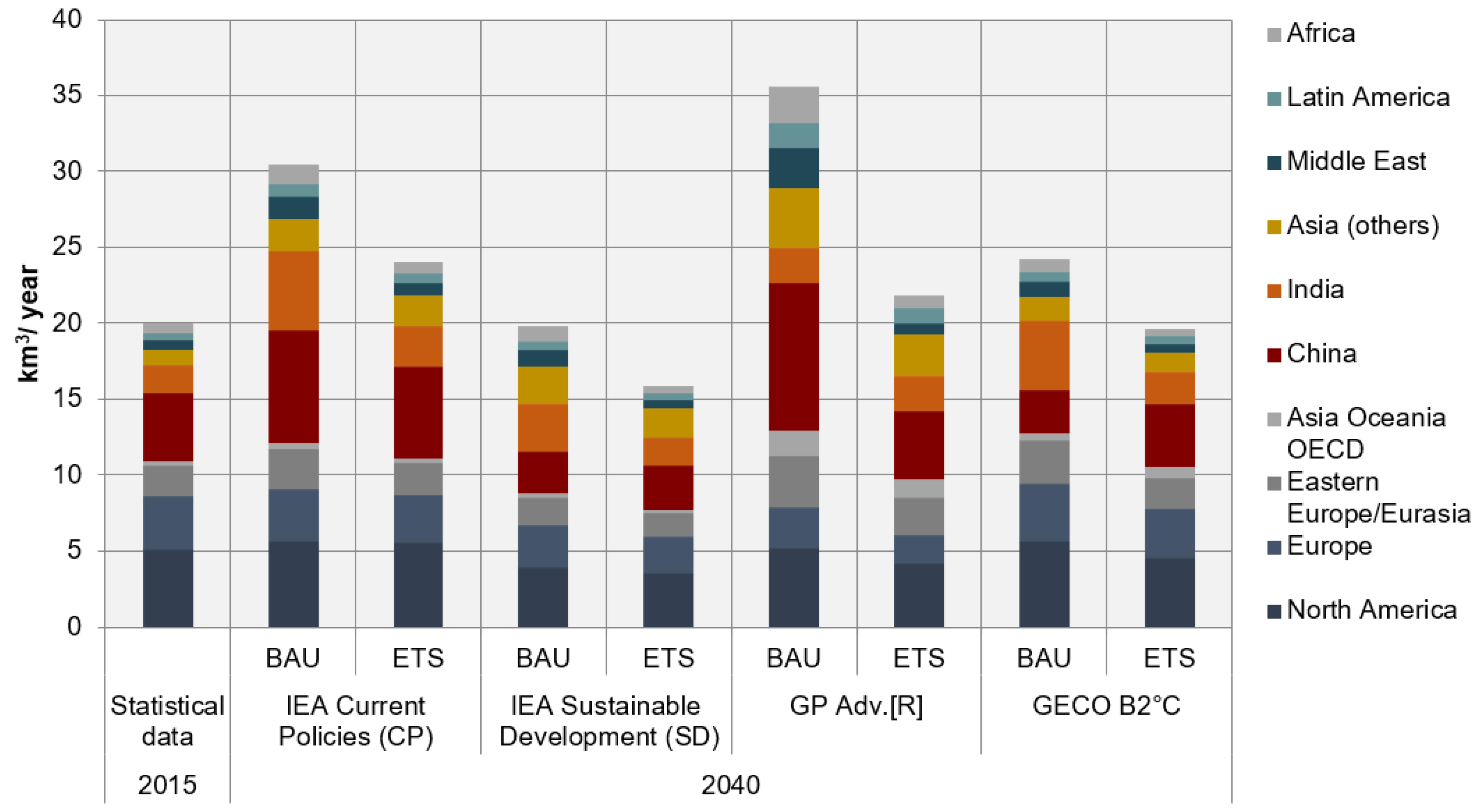
| Study | Time Horizon | Scenario | Greenhouse Gas Emission Changes 2040 (Compared to 1990) | Strategy Summaries |
|---|---|---|---|---|
| World Energy Outlook [39] | 2040 | Reference scenario: International Energy Agency (IEA) | Current Policies (CP) | +104% |
|
| International Energy Agency (IEA) | Sustainable Development (SD) | −13% |
| ||
| The advanced energy (r)evolution [40] | 2050 | Greenpeace (GP) | Advanced Energy Revolution (Ad.(R)) | −61% |
|
| Global Energy and Climate Outlook (GECO) [41] | 2050 | GECO | B2°C | +1% |
|
| Business as Usual Scenario (BAU) | Evolving Technology Scenario (ETS) | |
|---|---|---|
| Power plants | Distribution of power plant types for the different energy sources remains fixed at the level of regional shares in 2015. | In the case of a decrease in electricity generation of a given energy source (e.g., coal), the most water-intensive power plant technology will be retired first (e.g., the steam turbine one). |
| In the case of an increase in electricity generation of a given energy source, the most water-efficient electricity generation technology will be implemented in the newly built power capacities (e.g., the combined cycle one). | ||
| Cooling systems | Distribution of cooling system shares by electricity generation technology remains fixed at the level of regional shares in 2015. | In the case of a decrease in electricity generation of a given energy source, the most water-intensive cooling technology will be retired first (e.g., once- through cooling). |
| In the case of an increase in electricity generation of a given energy source, a fixed regional share of a cooling tower and dry cooling technology is applied to the power capacity increase. |
| Region | Cooling System | |
|---|---|---|
| CT | DC | |
| Africa | 0.2 | 0.8 |
| Asia Oceania OECD | 0.5 | 0.5 |
| Asia (Other) | 0.5 | 0.5 |
| China | 0.4 | 0.6 |
| Eastern Europe/Eurasia | 0.5 | 0.5 |
| Europe | 0.5 | 0.5 |
| India | 0.5 | 0.5 |
| Latin America | 0.5 | 0.5 |
| The Middle East | 0.1 | 0.9 |
| North America | 0.5 | 0.5 |
© 2020 by the authors. Licensee MDPI, Basel, Switzerland. This article is an open access article distributed under the terms and conditions of the Creative Commons Attribution (CC BY) license (http://creativecommons.org/licenses/by/4.0/).
Share and Cite
Terrapon-Pfaff, J.C.; Ortiz, W.; Viebahn, P.; Kynast, E.; Flörke, M. Water Demand Scenarios for Electricity Generation at the Global and Regional Levels. Water 2020, 12, 2482. https://doi.org/10.3390/w12092482
Terrapon-Pfaff JC, Ortiz W, Viebahn P, Kynast E, Flörke M. Water Demand Scenarios for Electricity Generation at the Global and Regional Levels. Water. 2020; 12(9):2482. https://doi.org/10.3390/w12092482
Chicago/Turabian StyleTerrapon-Pfaff, Julia C., Willington Ortiz, Peter Viebahn, Ellen Kynast, and Martina Flörke. 2020. "Water Demand Scenarios for Electricity Generation at the Global and Regional Levels" Water 12, no. 9: 2482. https://doi.org/10.3390/w12092482
APA StyleTerrapon-Pfaff, J. C., Ortiz, W., Viebahn, P., Kynast, E., & Flörke, M. (2020). Water Demand Scenarios for Electricity Generation at the Global and Regional Levels. Water, 12(9), 2482. https://doi.org/10.3390/w12092482





